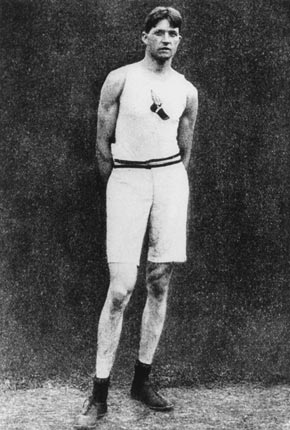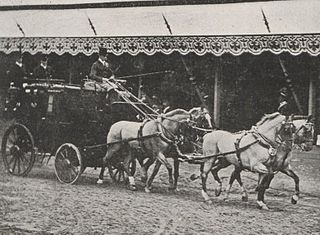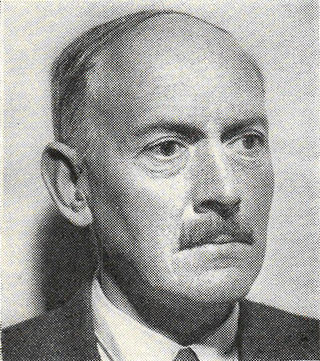
The men's high jump was a track & field athletics event at the 1900 Summer Olympics in Paris. It was held on July 15, 1900. Eight athletes from seven nations competed in the high jump. The event was won by Irving Baxter of the United States, the nation's second consecutive victory in the men's high jump. Great Britain and Hungary each took medals in their first appearance in the event.

The men's long jump was a track & field athletics event at the 1900 Summer Olympics in Paris. It was held on July 14 and July 15, 1900. 12 athletes from six nations competed. The event was won by Alvin Kraenzlein of the United States, the second consecutive victory for the American team. Myer Prinstein, also an American, took silver. Patrick Leahy, an Irish athlete competing for Great Britain, took bronze; it was the first long jump medal for a non-American athlete as the United States had swept the 1896 medals.

The men's triple jump was a track & field athletics event at the 1900 Summer Olympics in Paris. It was held on July 16, 1900. 13 athletes from six nations competed. The event was won by Myer Prinstein of the United States, the nation's second consecutive victory in the men's triple jump. Prinstein became the first, and through the 2016 Games, only, person to have won both the long jump and the triple jump. James Brendan Connolly took second, making him the first man to medal twice in the triple jump. Lewis Sheldon finished third, completing what would later be known as a medal sweep.

The men's standing high jump was a track & field athletics event at the 1900 Summer Olympics in Paris. It was held on July 16, 1900. Three athletes, all from the United States, competed in the standing high jump. The event was won by Ray Ewry of the United States, who took gold in all three of the standing jumps in 1900. His teammate Irving Baxter earned silver in all three 1900 standing jumps. The American sweep was completed with Lewis Sheldon taking bronze.

The men's standing long jump was a track & field athletics event at the 1900 Summer Olympics in Paris. It was held on July 16, 1900. Four athletes from two nations competed in the standing long jump. The event was won by Ray Ewry of the United States, with his teammate Irving Baxter the runner-up; the two dominated all three of the standing jumps in 1900, finishing first and second in each. Ewry would take gold medals in all eight standing jump events from 1900 to 1908. The bronze medal was won by Émile Torchebœuf of France.

The men's standing triple jump was a track & field athletics event at the 1900 Summer Olympics in Paris, France. It was held on July 16, 1900. 10 athletes from four nations competed in the standing triple jump. The event was won by Ray Ewry of the United States, who took gold in all three of the standing jumps in 1900. His teammate Irving Baxter earned silver in all three 1900 standing jumps. The American sweep was completed with Robert Garrett taking bronze.

Belgium competed at the 1900 Summer Olympics in Paris, France. It was the first appearance of the European nation. Belgium was represented in France by 78 athletes, all of them male, who competed in 11 disciplines. They comprised 95 entries in 28 events.
Émile Léon Fisseux was a French competitor in the sport of archery. Fisseux competed in one event in Archery at the 1900 Summer Olympics, taking third place in the 50 metre Au Cordon Doré competition. His score of 28 points was one point behind the second-place archer, Hubert Van Innis, and three points behind the winner, Henri Hérouin. While Fisseux received no medal at the time, he is currently considered to be a bronze medallist by the International Olympic Committee.

The Russian Empire competed at the 1900 Summer Olympics in Paris. It was the first appearance of the European nation, which had entered the names of competitors for the first modern Olympics in 1896 but had failed to appear.

The men's 20 metre rapid fire pistol was one of the competitions in the 1900 Summer Olympics shooting events in Paris. It was held from August 1 to August 4, 1900. Six athletes from 2 nations competed. This event was contested for prize money by professionals. It is no longer included in the International Olympic Committee website's database of Olympic medal events. Five of the six shooters were from France; the host nation swept the medals as Maurice Larrouy won with Léon Moreaux second and Eugène Balme third.
Jenö Pál Koppán was a Hungarian track and field athlete who competed at the 1900 Summer Olympics in Paris.

The Au Chapelet at 50 metres event was part of the archery programme at the 1900 Summer Olympics. Qualification for the event was through the large open team events, with the top six individual archers competing in the individual competition. The identities of the fifth and sixth place archers are unknown. All of the scores are unknown.

The Sur la Perche à la Herse event was part of the archery programme at the 1900 Summer Olympics. Only the names of the three top placers are known.

The Sur la Perche à la Pyramide event was part of the archery programme at the 1900 Summer Olympics. Only the names of the three top placers are known.

Obstacle jumping was one of five equestrian competitions held in late May and early June 1900 at the International Horse Show in Paris. The event was part of the Exposition Universelle, and later classified as part of the 1900 Summer Olympics. It was similar to the modern show jumping event. 45 competitors entered, though only 37 competed, with some information unknown. The event was won by Aimé Haegeman of Belgium, with his countryman Georges Van Der Poele taking second and Louis de Champsavin of France in third.

The high jump was one of five equestrian competitions held in late May and early June 1900 at the International Horse Show in Paris. The event was part of the Exposition Universelle, and later classified as part of the 1900 Summer Olympics. It is the only Olympic Games to date to feature an equestrian high jump competition. Nineteen competitors entered the high jump competition, although not all details have been discovered.

The long jump was one of five equestrian competitions held in late May and early June 1900 at the International Horse Show in Paris. The event was part of the Exposition Universelle, and later classified as part of the 1900 Summer Olympics. It is the only Olympic Games to feature an equestrian long jump competition. Of the seventeen competitors who entered, around half are known by name. The event was won by Constant van Langhendonck of Belgium, with Gian Giorgio Trissino of Italy in second and Jacques de Prunelé of France in third.

The "hacks and hunter combined", also known as the "chevaux de selle", was one of five equestrian competitions held in late May and early June 1900 at the International Horse Show in Paris. The event was part of the Exposition Universelle, and later classified as part of the 1900 Summer Olympics. It is unknown how many riders competed. The top four placers are known, as are about half the remaining riders who competed, including three women. As an upper limit, 50 men and 1 woman are listed as entrants in the Official Report, but it is almost certain that not all actually competed.

The four-in-hand mail coach driving was one of five equestrian competitions held in late May and early June 1900 at the International Horse Show in Paris. The event was part of the Exposition Universelle, and later classified as part of the 1900 Summer Olympics. There were 31 entrants listed for the event; all 28 of them are known by name. The event was won by the team of Georges Nagelmackers of Belgium. The teams of Léon Thome and Jean de Neuflize, both of France, were classified in second and third place respectively.

Teodor "Tore" Blom was a Swedish track and field athlete who competed at the 1900 Summer Olympics in Paris, France.


















